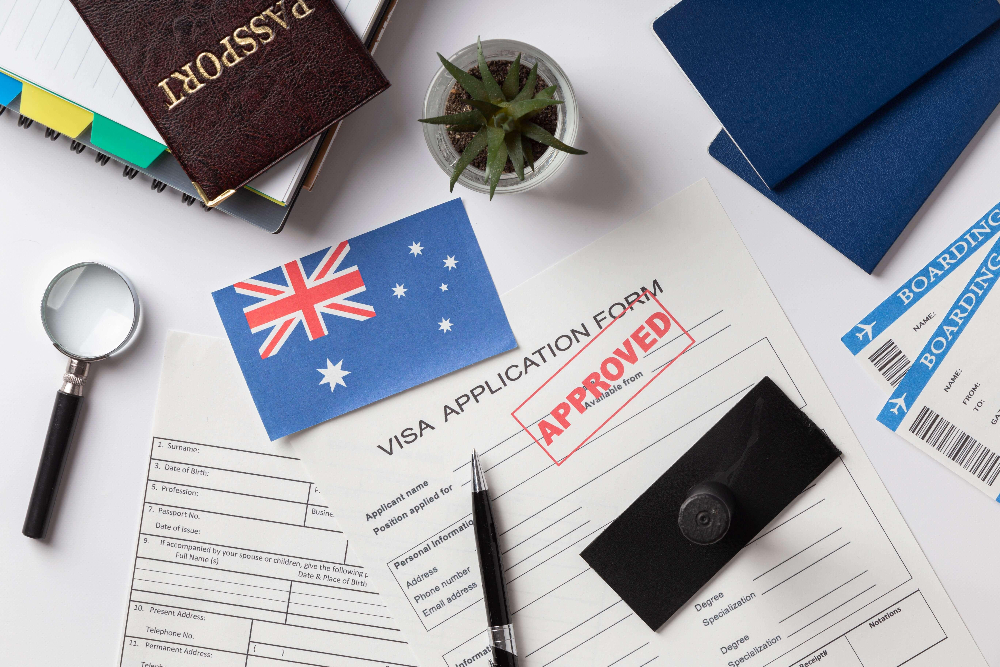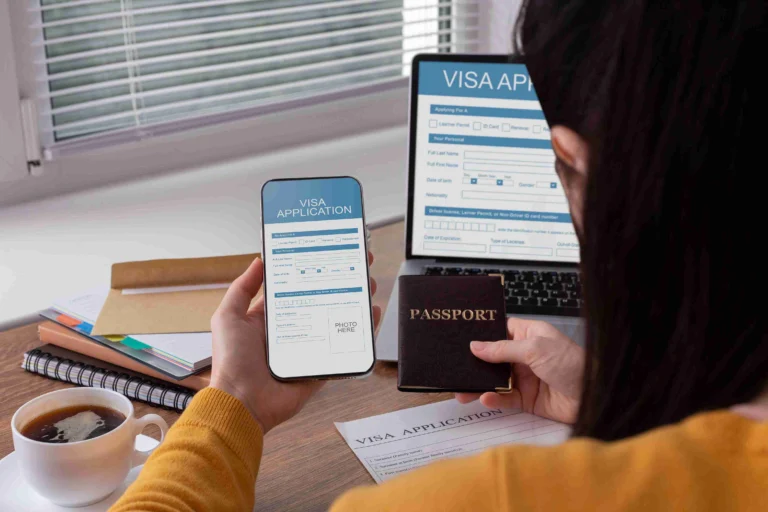
Australia Work Permit from India: Requirements, Process, and Tips
Latest Facts and News
- As of September 2024, India officially joined the Working Holiday Maker visa program, becoming the 50th partner country.
- Australia may grant up to 1,000 first Work and Holiday (subclass 462) visas to eligible Indian citizens aged 18-30 each program year.
- A new visa ballot process for the Work and Holiday visa was introduced on October 1, 2024, for the 2024-2025 program year.
- The Australia-India Economic Cooperation and Trade Agreement (AI-ECTA) has facilitated this new partnership.
Australia has always been a dream destination for Indian professionals with evergreen scope and a high-quality life, along with a welcoming work culture. But for many, the ways to get there isn’t that simple.
With so many options for visas, strict eligibility criteria, and changes like the new visa ballot system, it becomes quite difficult to know where to begin. Aside from that, a lack of proper guidance will make things difficult, potentially slowing down the process or leading to rejection.
This blog post will provide a simplified guide to applying for an Australia work permit from India. You will find practical tips and insights on moving with confidence, whether you are looking for temporary work or long-term residency.
Understanding Australian Work Visas for Indians
Australia has been one of the most preferred countries for Indians when it comes to seeking new overseas employment opportunities. It provides Indians with a high standard of living, a highly competitive job market, and an inclusive workplace culture, all of which speak well for skilled immigrants’ prospects.
If you’re planning to work in Australia, understanding the available visa options is the first step. Australian work visas for Indians fall into two main categories that we will read in the below section. These visas allow individuals to live, work, and, in some cases, even settle in Australia.
Here’s a simple guide to the 2 key visa types:
1. Temporary Work Visas
These visas are ideal for short-term employment opportunities in Australia:
- Temporary Skill Shortage (TSS) Visa (Subclass 482): For skilled workers who have a job offer and sponsorship from an Australian employer.
- Work and Holiday Visa Australia (Subclass 417): For young individuals looking to travel and work in Australia.
- Skilled Regional (Provisional) Visa (Subclass 491): For skilled workers willing to live and work in regional parts of Australia.
2. Permanent Work Visas
If you’re planning to stay in Australia long-term, these visas might be right for you:
- Skilled Independent Visa (Subclass 189): For highly skilled workers who do not need family or employer sponsorship Australia.
- Employer Nomination Scheme (ENS) Visa (Subclass 186): For workers who are nominated by an Australian employer.
- Skilled Nominated Visa (Subclass 190): For skilled workers nominated by a state or territory government.
Each visa serves a specific purpose, so choosing the right one depends on your job type, skills, and goals. Take time to review the requirements and ensure you meet the criteria before applying.
And if you still need help, reach out to Visa Axis today. We have been doing this for 10+ years for so many of our clients, and we can help you also.
Eligibility Requirements for Australian Work Permits
If you want an Australia work permit from India, then there are certain basic requirements you need to meet. Though the requirements will depend on the visa type, important aspects will include age, skills, education, and work experience.
So, here’s a checklist to help you remember what you need to know:
- Check Your Skills and Occupation: You’ll need to prove your skills match Australian standards. Your job must also be on Australia’s Skilled Occupation List, which includes professions that are in demand.
- Earn Enough Points: Australia has a point system for visas, such as the Skilled Independent Visa (Subclass 189). It is based on various aspects like age, experience in employment, education, and English skills. You have better chances when you collect more points.
- Meet the English Requirements: You must show you can read, write, and speak English well. Tests like IELTS or PTE are commonly required, and higher scores can give you extra points for skilled visas.
- Stay Within the Age Limit: An official guideline from the issuing body clearly states that most visas are issued to persons less than 45 years old. You’ll also need the right qualifications and work experience to match the job you’re applying for.
How to Apply for a Work Permit in Australia from India?
This may sound like a difficult process, but getting an Australia work permit from India can become easier if you break the process into simple steps. Here’s how to apply for a work permit in Australia from India:
1. Find the Right Visa for You
Choose the visa that fits your skills and goals. Options include temporary visas like the TSS Visa (Subclass 482) or permanent ones like the Skilled Independent Visa (Subclass 189).
2. Complete a Skills Assessment and English Test
Get your skills evaluated to ensure they meet Australian standards. You’ll also need to take an English test, like IELTS or PTE, as this is a key requirement for most visas.
3. Submit an Expression of Interest (EOI)
If required, submit an EOI through SkillSelect. This tells the Australian government about your skills, the visa you want, and if you’d like a state nomination.
4. Prepare All Your Documents
Gather documents like your education certificates, proof of work experience, and identity papers. Make sure everything is up-to-date and matches the visa requirements.
5. Apply for Your Visa Online
Once everything is ready, submit your application online. Double-check the details and be prepared for health and character checks during the process.
Now that we know how to get a work permit in Australia from India, let’s get to the Australia work permit processing time from India.
Australia Work Permit Processing Time from India
Knowing the processing times for different visas is essential if you are planning to get your Australia work permit from India.
Here’s a breakdown of Australia work permit processing time from India:
- Temporary Skill Shortage (TSS) Visa (Subclass 482): The processing time for this visa is typically between 1 to 3 months. It’s a great option for skilled workers with a job offer from an Australian employer.
- Skilled Independent Visa (Subclass 189): This visa usually takes about 6 to 12 months to process. It’s for highly skilled workers who don’t need sponsorship from an employer or family member.
- Skilled Nominated Visa (Subclass 190): Processing for this visa takes around 8 to 12 months. It’s designed for skilled workers nominated by a state or territory government in Australia.
- Skilled Work Regional (Provisional) Visa (Subclass 491): This visa typically takes 6 to 12 months to process. It’s for skilled workers who are willing to live and work in regional areas of Australia.
| Note: Processing times can vary based on factors like the accuracy of your application and the number of applications the immigration department is handling. Be sure to double-check the latest timelines on official immigration websites. |
Validity of Australian Work Permits
After understanding the processing times for different Australian work visas, it’s equally important to know how long each visa remains valid.
The validity period determines how long you can live and work in Australia under a specific visa. Below is a detailed table explaining the validity of each work visa:
| Visa Type | Validity |
| Temporary Skill Shortage (TSS) Visa (Subclass 482) | Up to 4 years. The duration depends on the job role and sponsorship agreement. |
| Skilled Independent Visa (Subclass 189) | Permanent residency. This visa allows indefinite stay with a pathway to citizenship. |
| Skilled Nominated Visa (Subclass 190) | Permanent residency. State nominations may come with additional commitments or conditions. |
| Skilled Work Regional (Provisional) Visa (Subclass 491) | Up to 5 years. Offers a pathway to permanent residency if eligibility criteria are met. |
Your visa will have a validity period, as stated in the major conditions of your visa grant letter. If you want to know the precise and most accurate information about your visa, always check an official immigration source.
Suppose you want help in determining these conditions or their effect on your Australia work permit from India. In that case, Visa Axis offers clear and detailed guidance and support so that you can know everything you require on the present status of your visa.
Also Read→ Latest Updates on Australian Visa Sub-classes 189, 190, and 491 in 2024
Tips for a Successful Australia Work Permit Application
Here are a few pointers that will make applying for an Australia work permit from India much more manageable:
1. Understand the Visa Requirements
Make sure you fully understand the eligibility criteria for your chosen visa. Research the details for options like the TSS Visa or Skilled Independent Visa to see what fits your goals and qualifications.
2. Keep Your Documents in Order
Always double-check that your documents are accurate and up-to-date. Things like your skills assessment, English language test scores, and work experience letters should meet the visa requirements.
3. Focus on Your Points Score
If your visa uses a points system, every Australian immigration points system counts. High scores in English tests, solid work experience, and advanced qualifications can significantly increase your chances of approval.
4. Be Honest in Your EOI
When filling out your Expression of Interest (EOI), be truthful and detailed. The more accurate your information, the smoother your application process will be.
5. Avoid Last-Minute Errors
Rushing through your application can lead to mistakes. Check all your details thoroughly before submitting to avoid delays or rejections.
Living and Working in Australia: What to Expect
It is a top destination for Indian expats when it comes to finding a place with a plethora of job opportunities along with a better standard of living. To help you settle in, here are some key insights into the Australian work culture, lifestyle, and practical considerations:
Work Culture
There is professionalism in the working culture of Australia. It encourages every employee to develop a good balance of work and life. Team cooperation, mutual respect, direct communication, and personal accountability are some of the most valued aspects in workplaces.
- Work Hours: Standard working hours are around 38 hours per week, with a strong emphasis on punctuality.
- Public Holidays: Australia observes several public holidays, including Australia Day (26th January) and ANZAC Day (25th April).
Cost of Living in Australia
Living in Australia can be affordable or expensive, depending on your lifestyle and location. Here’s a breakdown of the main living expenses you’ll need to budget for:
1. Average Living Costs
Excluding rent, the average monthly cost of living in Australia ranges between AUD 1,400 and AUD 2,500. This includes food, transportation, and medical needs. Your total expenses will vary based on where you live and how you manage your spending.
2. Accommodation Costs
Accommodation is often the biggest expense for international students and Indian expatriates. Options like shared apartments, residence halls, or homestays come with varying costs.
| Accommodation Type | Average Monthly Cost (AUD) |
| In-home care | 450–1,200 |
| Student residence halls | 440–1,100 |
| Apartment rental | 750–1,700 |
| Shared rental home/apartment | 380–850 |
3. Food and Grocery Costs
Cooking at home is a more affordable option than eating out in Australia. Local supermarkets sell a wide range of ingredients to prepare budget-friendly meals.
| Grocery Products | Average Cost (AUD) |
| White Rice (1 kg) | 3.60 |
| White Milk (1 Litre) | 2.02 |
| Apples (1 kg) | 5.20 |
| Oranges (1 kg) | 2.60 |
| Tomatoes (1 kg) | 6.00 |
| Water (1.5 Litres) | 2.40 |
| Bread | 3.41 |
| Potatoes (1 kg) | 3.81 |
| Lettuce | 5.50 |
| Cheese (500 gm) | 7.70 |
| Bananas (1 kg) | 4.50 |
| Fast Food Combo Meal | 15.00 |
| Eggs (12) | 8.00 |
4. Transportation Costs
Australia is a country connected and well-versed in transport systems. Buses and trains are common modes of transportation that can get you from one location to another at a low cost. They have discounts for overseas students to enable them to travel at lower prices.
| Transportation | Average Cost (AUD) |
| One-way local transport ticket | 3–6 |
| Taxi tariff (start) | 3–7 |
| Gasoline (1 Litre) | 1.2–1.6 |
| Taxi (1 km) | 2–3 |
| Monthly public transport pass | 100–200 |
Healthcare in Australia
Healthcare is a critical aspect to consider when moving to Australia. The country offers high-quality medical services through a combination of public and private healthcare systems.
Medicare is Australia’s public healthcare system for permanent residents and citizens. It helps cover:
- Doctor visits and hospital treatments at little to no cost.
- Prescription medications.
- Community nursing, physiotherapy, and basic dental care for kids.
Australia has 31 Primary Health Networks (PHNs) that improve healthcare services. PHNs support local hospitals, clinics, nurses, and doctors.
Extra services like mental health programs, after-hour clinics, and health education were needed. They also make sure healthcare systems work smoothly together.
Healthcare for PR holders and citizens is funded by taxes. Residents pay 2% of their income as a Medicare Levy to support the public system.
Make Your Australian Work Dream a Reality With Visa Axis!
Planning to get an Australia work permit from India comes with many steps, and it’s important to get them right. While this blog covered visa types and basic requirements, one helpful tip is to check your eligibility early. Tools like point calculators can give you a clear idea of your chances and help you plan better.
If you feel stuck or unsure about the process, getting expert advice can make all the difference. Visa Axis not only guides you through every step but also offers its own Australia PR Points Calculator. This tool helps you see how close you are to meeting the criteria and what you can improve.
With the right guidance and tools, starting your Australian work journey becomes much easier. Visa Axis is here to help you make it happen.
Frequently Asked Questions
1: What is the minimum salary requirement for an Australia work permit?
For most skilled workers in Australia, the average annual salary typically falls between AUD 85,000 and 95,000. The exact salary requirement can depend on the type of work visa and the job you are applying for. It’s important to check the specific visa guidelines to ensure your job offer meets the necessary criteria.
2: Can I bring my family with me on an Australian work visa?
Australia has provisions where the family would be allowed to come along with you on your work visa. The family can include your spouse or de facto partner, children under the age of 25, and some other dependent relatives like parents and grandparents.
For them to come to Australia, they will have to apply for an Australia Dependent Visa, which will then allow them to stay, study, or work dependent on the visa conditions in Australia.
3: Is it possible to switch employers while on a temporary work visa in Australia?
You are permitted to switch employers while on a TSS482 visa. In this event, your new employer must lodge a nomination application with the Department of Home Affairs, and you can only start working for them after the nomination is approved.
If the new position is not similar to your job and the duties are not the same, then it would require reassessment. Make sure you understand the requirements of your visa and always alert the Department of Home Affairs of any changes.
4: How long can I stay in Australia on a work permit?
The duration of your stay in Australia on a work permit depends on the type of visa. For example, the Subclass 400 visa typically allows a stay of up to three months. In exceptional cases, it may be extended to six months, but this is at the discretion of the assessing officer. Always check your specific visa conditions for exact details.
5: What happens if my work permit application is rejected?
If your Australia work permit from India application is rejected, don’t worry—you still have options. Australian skilled migration law allows you to reapply or appeal your case based on your circumstances. Many applicants who faced rejection have successfully obtained their visa by addressing the reasons for refusal and applying again under the same or a different subclass. Your eligibility and next steps will depend on your situation.



